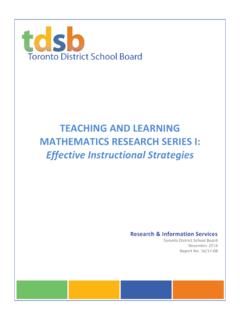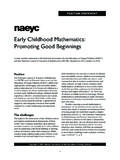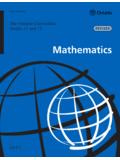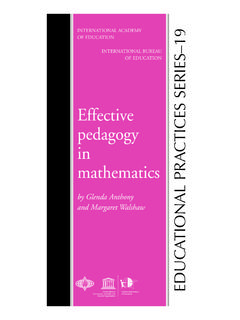Transcription of Inside the Black Box: Raising Standards Through Classroom ...
1 Illustration 1998 by A. J. Garces Raising the Standards of learning that are achieved Through schooling is an important national priority. Inrecent years, governments throughout the world have been more and more vigorous in making changes inpursuit of this aim. National, state, and district Standards ; target setting; enhanced programs for the externaltesting of students' performance; surveys such as NAEP (National Assessment of Educational Progress) andTIMSS (Third International Mathematics and Science Study); initiatives to improve school planning andmanagement; and more frequent and thorough inspection are all means toward the same end. But the sum ofall these reforms has not added up to an effective policy because something is is driven by what teachers and pupils do in classrooms. Teachers have to manage complicated anddemanding situations, channeling the personal, emotional, and social pressures of a group of 30 or moreyoungsters in order to help them learn immediately and become better learners in the future.
2 Standards canbe raised only if teachers can tackle this task more effectively. What is missing from the efforts alluded toabove is any direct help with this task. This fact was recognized in the TIMSS video study: "A focus onstandards and accountability that ignores the processes of teaching and learning in classrooms will notprovide the direction that teachers need in their quest to improve."1In terms of systems engineering, present policies in the and in many other countries seem to treat theclassroom as a Black box. Certain inputs from the outside -- pupils, teachers, other resources, managementrules and requirements, parental anxieties, Standards , tests with high stakes, and so on -- are fed into the outputs are supposed to follow: pupils who are more knowledgeable and competent, better test results,teachers who are reasonably satisfied, and so on.
3 But what is happening Inside the box? How can anyone besure that a particular set of new inputs will produce better outputs if we don't at least study what happensinside? And why is it that most of the reform initiatives mentioned in the first paragraph are not aimed atgiving direct help and support to the work of teachers in classrooms?The answer usually given is that it is up to teachers: they have to make the Inside work better. This answer isnot good enough, for two reasons. First, it is at least possible that some changes in the inputs may becounterproductive and make it harder for teachers to raise Standards . Second, it seems strange, even unfair, toleave the most difficult piece of the Standards - Raising puzzle entirely to teachers. If there are ways in whichInside the Black Box: Raising StandardsThrough Classroom Assessment By Paul Black and Dylan WiliamFirm evidence shows that formative assessment is an essential componentof Classroom work and that its development can raise Standards ofachievement, Mr.
4 Black and Mr. Wiliam point out. Indeed, they know of noother way of Raising Standards for which such a strong prima facie casecan be makers and others can give direct help and support to the everyday Classroom task of achieving betterlearning, then surely these ways ought to be pursued article is about the Inside of the Black box. We focus on one aspect of teaching: formative we will show that this feature is at the heart of effective ArgumentWe start from the self-evident proposition that teaching and learning must be interactive. Teachers need toknow about their pupils' progress and difficulties with learning so that they can adapt their own work to meetpupils' needs -- needs that are often unpredictable and that vary from one pupil to another. Teachers can findout what they need to know in a variety of ways, including observation and discussion in the Classroom andthe reading of pupils' written use the general term assessment to refer to all those activities undertaken by teachers -- and by theirstudents in assessing themselves -- that provide information to be used as feedback to modify teaching andlearning activities.
5 Such assessment becomes formative assessment when the evidence is actually used toadapt the teaching to meet student is nothing new about any of this. All teachers make assessments in every class they teach. But thereare three important questions about this process that we seek to answer:*Is there evidence that improving formative assessment raises Standards ?*Is there evidence that there is room for improvement?*Is there evidence about how to improve formative assessment?In setting out to answer these questions, we have conducted an extensive survey of the research have checked Through many books and Through the past nine years' worth of issues of more than 160journals, and we have studied earlier reviews of research. This process yielded about 580 articles or chaptersto study. We prepared a lengthy review, using material from 250 of these sources, that has been published ina special issue of the journal Assessment in Education, together with comments on our work by leadingeducational experts from Australia, Switzerland, Hong Kong, Lesotho, and the conclusion we have reached from our research review is that the answer to each of the three questionsabove is clearly yes.
6 In the three main sections below, we outline the nature and force of the evidence thatjustifies this conclusion. However, because we are presenting a summary here, our text will appear strong onassertions and weak on the details of their justification. We maintain that these assertions are backed byevidence and that this backing is set out in full detail in the lengthy review on which this article is believe that the three sections below establish a strong case that governments, their agencies, schoolauthorities, and the teaching profession should study very carefully whether they are seriously interested inraising Standards in education. However, we also acknowledge widespread evidence that fundamentalchange in education can be achieved only slowly -- Through programs of professional development that buildon existing good practice. Thus we do not conclude that formative assessment is yet another "magic bullet"for education.
7 The issues involved are too complex and too closely linked to both the difficulties ofclassroom practice and the beliefs that drive public policy. In a final section, we confront this complexity andtry to sketch out a strategy for acting on our Improving Formative Assessment Raise Standards ?A research review published in 1986, concentrating primarily on Classroom assessment work for childrenwith mild handicaps, surveyed a large number of innovations, from which 23 were Those chosensatisfied the condition that quantitative evidence of learning gains was obtained, both for those involved inthe innovation and for a similar group not so involved. Since then, many more papers have been publisheddescribing similarly careful quantitative experiments. Our own review has selected at least 20 more studies.(The number depends on how rigorous a set of selection criteria are applied.)
8 All these studies show thatinnovations that include strengthening the practice of formative assessment produce significant and oftensubstantial learning gains. These studies range over age groups from 5-year-olds to universityundergraduates, across several school subjects, and over several research purposes, learning gains of this type are measured by comparing the average improvements inthe test scores of pupils involved in an innovation with the range of scores that are found for typical groupsof pupils on these same tests. The ratio of the former divided by the latter is known as the effect size. Typicaleffect sizes of the formative assessment experiments were between and These effect sizes are largerthan most of those found for educational interventions. The following examples illustrate some practicalconsequences of such large gains.*An effect size of would mean that the average pupil involved in an innovation would record thesame achievement as a pupil in the top 35% of those not so involved.
9 *An effect size gain of in the recent international comparative studies in mathematics5 would haveraised the score of a nation in the middle of the pack of 41 countries ( , the ) to one of the top of these studies arrive at another important conclusion: that improved formative assessment helps lowachievers more than other students and so reduces the range of achievement while Raising achievementoverall. A notable recent example is a study devoted entirely to low-achieving students and students withlearning disabilities, which shows that frequent assessment feedback helps both groups enhance Any gains for such pupils could be particularly important. Furthermore, pupils who come to seethemselves as unable to learn usually cease to take school seriously. Many become disruptive; others resortto truancy. Such young people are likely to be alienated from society and to become the sources and thevictims of serious social it seems clear that very significant learning gains lie within our grasp.
10 The fact that such gains havebeen achieved by a variety of methods that have, as a common feature, enhanced formative assessmentsuggests that this feature accounts, at least in part, for the successes. However, it does not follow that itwould be an easy matter to achieve such gains on a wide scale in normal classrooms. Many of the reports wehave studied raise a number of other issues.*All such work involves new ways to enhance feedback between those taught and the teacher, waysthat will require significant changes in Classroom practice.*Underlying the various approaches are assumptions about what makes for effective learning -- inparticular the assumption that students have to be actively involved.*For assessment to function formatively, the results have to be used to adjust teaching and learning;thus a significant aspect of any program will be the ways in which teachers make these adjustments.








